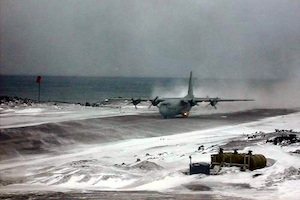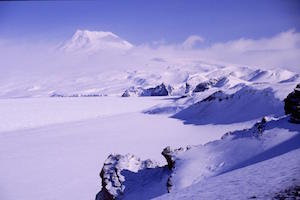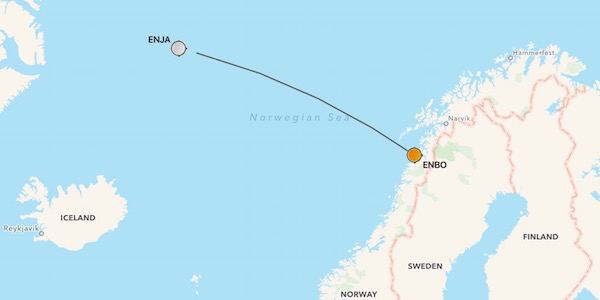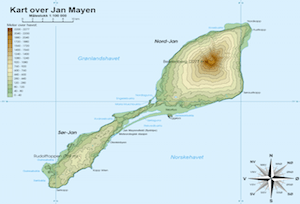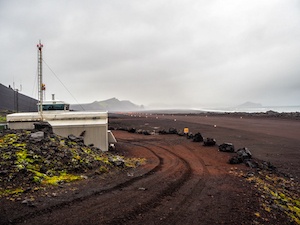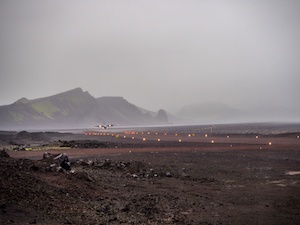Jan Mayensfield, Jan Mayen Island
The airfield that is on the top of my shortlist / wishlist is Jan Mayensfield on the remote island of Jan Mayen. However, it can only be visited when the weather conditions and forecasts are in our favor and with permission from the Norwegian Airforce. The island has played a role in Dutch history with Dutch whalers hunting in the area and living on the island. Today, the weather station is what interest us as well as the LORAN radio transmitter history and its active volcano.
Jan Mayensfield (ICAO: ENJA) is an aerodrome serving Olonkinbyen on the small island. Operated by the Norwegian Armed Forces, the airstrip serves the island’s only population at the combined military and meteorological station at Olonkinbyen. It has a 1,500-meter (4,921 ft) dirt runway numbered 06–24.
The airfield was built in connection with the LORAN-C transmitter at Olonkinbyen some 55 years ago. Jan Mayensfield is served eight times per year by Lockheed C-130 Hercules aircraft of the 335 Squadron from Bodø Main Air Station, which provide supplies and change crew at the outpost.
One option is to follow the coast of Norway to Bodø Airport (ENBO). From here we would fly westbound towards Jan Mayen. There is nothing there on the island; no gas station nor any facilities for repairs, so we need to prepare well and make a last-minute go-no go decision taking the latest weather forecast, expected winds aloft and other factors into consideration. Another option is to approach Jan Mayen from Iceland or (only during the summer period) from the eastcoast of Greenland.
Dutch roots to the island
The first verified discoveries of Jan Mayen occurred in the summer of 1614. The Dutchman Fopp Gerritsz, while in command of a whaling expedition sent out by the Englishman John Clarke, of Dunkirk, claimed (in 1631) to have discovered the island on June 28 and named it “Isabella”. In January the Noordsche Compagnie (Northern Company), modelled on the Dutch East India Company, had been established to support Dutch whaling in the Arctic. Two of its ships, financed by merchants from Amsterdam and Enkhuizen, reached Jan Mayen in July 1614. The captains of these ships—Jan Jacobszoon May van Schellinkhout on the Gouden Cath (Golden Cat) and Jacob de Gouwenaer on the Orangienboom (Orange Tree)—named it Mr. Joris Eylant after the Dutch cartographer Joris Carolus who was on board and mapped the island. The captains acknowledged that a third Dutch ship, the Cleyn Swaentgen (Little Swan) captained by Jan Jansz Kerckhoff and financed by Noordsche Compagnie shareholders from Delft, had already been at the island when they arrived. They had assumed the latter, who named the island Maurits Eylandt (or Mauritius) after Maurice of Nassau, Prince of Orange, would report their discovery to the States General. However, the Delft merchants had decided to keep the discovery secret and returned in 1615 to hunt for their own profit. The ensuing dispute was only settled in 1617, though both companies were allowed to whale at Jan Mayen in the meantime. So it is quite of interest to have this island linked to our national history.
The airfield
The runway is 1500 meters in length and made of compacted dirt. The NDB beacon JAN is located nearby the airfield and as distilled from the pictures above, there are runway edge lights. As can be expected from a location this remote, the weather can be quite bad and visibility is not a given.
The island has a meteo station. One of our objectives is to visit this station and talk to the meteorologists about their work on the island. The below video is not in English, but gives a good impression of the island and the meteorological station. I am not sure if the LORAN facilities are still operational and how such a facility is considered nowadays in the light of the modern age of satellites. We as aviators hope to learn more about this as well and to hear some about the history of the island and possibly the effect of climate changes or other effects that are noted by the staff of around 18 people (in winter time) in the island.
Currently we have not been given permission yet to land on the airfield by the Norwegian authorities. However, I will continue to pursue a visit.
